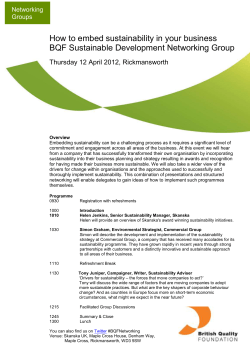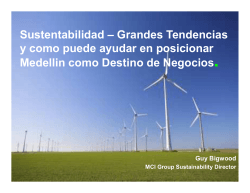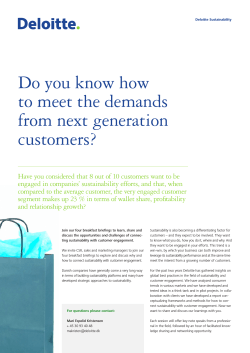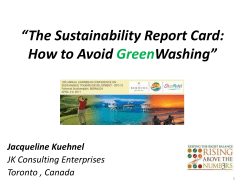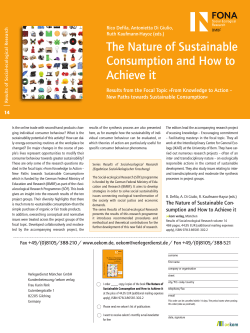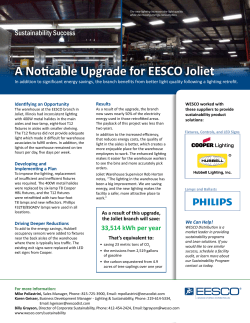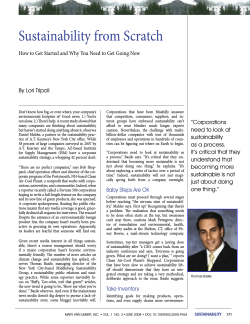
Below The Waterline. How To Integrate Needs, Values, Emotions Into Societal Processes
Exploratory Workshop Scheme Standing Committee for the Humanities (SCH) ESF Exploratory Workshop on Below The Waterline. How To Integrate Needs, Values, Emotions Into Societal Processes Towards Sustainable Development. Vienna (Austria), June 1–3 2011 Convened by: Ines Omann, Lisa Bohunovsky and Felix Rauschmayer SCIENTIFIC REPORT 1. EXECUTIVE SUMMARY From June 1st to June 3rd 2011, 17 participants from 8 countries took part at the ESF Exploratory Workshop “Below The Waterline. How To Integrate Needs, Values, Emotions Into Societal Processes Towards Sustainable Development” which was held at the Berghotel Tulbingerkogel, close to Vienna, Austria. The meeting venue was located on the mountainside of a small hill near Vienna in the middle of Wienerwald (Vienna forest) remote from other settlements. Thus, although near Vienna, it allowed for working in a silent surrounding close to nature. This was very much appreciated by the participants, contributed to the positive atmosphere in the group and supported the approach of the workshop. Scientific objectives Social science research for sustainable development is very often based on the approach of post-normal-science. It is characterised by including peers and stakeholders into the processes, by acknowledging and addressing uncertainty of future developments and of impacts of these developments on society, and it is driven by societal problems rather than by scientific curiosity. Among these societal problems are climate change, poverty, population growth, resource conflicts, and migration, to only mention some of them. However, we still face many challenges in order to reverse the currently unsustainable development paths found all over the world. Besides an incomplete or not yet started implementation of research results we also see shortcomings of existing research. Thus, this workshop aimed to contribute to an emerging integral science based on postnormal-science and in this way to enlarge the mainly cognitive concept of the current discussion on sustainable development and of post-normal-science, which does not deal with the subjective and emotional side of the political challenges, decision processes and policy implementation. Integral science is supposed to address the individual as well as the collective perspective, the inside (issues within an individual or system such as culture or values) as well as the outside (issues that are outside an individual or system such as behaviour or systems characteristics perspective). So far sustainable development science focused on the “outside perspective”, of both the society and the individual. In order to provide an integrative transition to sustainable development, both these internal roots of behaviour (individual and collective) and their interplay with the context should be more taken into account. The main objective of the workshop was therefore to explore how, i.e. based on which theories and with which methods, science for sustainable development shall/can be expanded to an integrative scientific approach (including the inner perspective) supporting a transition towards sustainable development. The focus was set on the internal context of the individuals and the society. Not only was the topic of the workshop integrative, also the exploration itself. It happened on the cognitive level (input talks, discussion) and on the emotional level through the experience of applying some methods addressing the inner context such as systemic constellations, Dynamic Facilitation or special forms of dialogue. Thus, the workshop was based on interand transdisciplinarity. Agenda On the first day of the workshop (June 1st) participants were first asked about their expectations of the workshop. Then, three presentations were held: the ESF presentation held by Kostas Gouliamos, the presentation of the framework on which the workshop was based on by Ines Omann and Felix Rauschmayer (Rauschmayer et al., 2010) and the keynote presentation by Tell Münzing dealing with “Integrating inner perspectives in transition processes”. Afterwards participants discussed the question “How can science for sustainable development be expanded to an integrative scientific approach?” This discussion was facilitated by Dynamic Facilitation (description see below). On the second day (June 2nd) methods (description see below) to address the inner context were presented: Worldwork, Dialogue, Dyade, Systemic Constellations and Dynamic Facilitation. In parallel sessions participants were then invited to test some of the presented methods and to share and discuss their experiences afterwards. The afternoon was organized in an open space format. The following working groups gathered to work on topics such as: (1) What method is appropriate in which context? (2) Self experiences and exercises to connect to the environment, (3) Structure of human consciousness and communication, (4) Sustainability value map, (5) Systemic constellation on “What does the inner perspective has to do with sustainable development”. Afterwards the working group proceedings were presented and discussed in plenary. The focus of the third workshop day (June 3rd) was on developing follow-up activities such as: further actions within ESF, scientific publications, joint project and events, policy papers and related processes. Overall conclusions The main objective of the workshop was largely met (as also confirmed by the ESF delegate). The workshop succeeded in adding a new dimension to post-normal science: the layer of the inner context. This focus was maintained by the organizers and supported by all participants with a high level of enthusiasm. With departing from the usual format of scientific workshops we discovered a drawback: We reached our aims fully to explore methods that were new to most of the participants and that are new to sustainability science; however it was hard (given the time constraints) in parallel to analyse the knowledge gained through these methods in a rigorous way. Thus, a deep theoretic occupation with these was not done through the workshop, but will be done in our future work where we will continue on dealing with the topics of the workshop. The organizers of the workshop are confident that the momentum created by this exploratory workshop is big enough to stimulate reflection and cooperation needed for analyzing our results theoretically and integrate them into our existing knowledge. This next step is necessary for including such methods into scientifically rigorous transdisciplinary processes for a sustainability transformation: only when we have some more methodological knowledge with regard to the analysis of results of such methods, we have a tool to better tailor the methods to their contexts of application. The workshop has shown – and participants agreed to this – that these methods have a high potential to contribute to a more profound transformation to sustainability. 2. SCIENTIFIC CONTENT OF THE EVENT Framework presentation Ines Omann and Felix Rauschmayer presented a framework (see Figure 1) describing the linkages between sustainable development and quality of life with emphasis on needs, values, capabilities and well-being. The presentation was based on chapter 1 of a book edited by them, „Sustainable Development: Capabilities, needs and well-being‟ (Rauschmayer et al., 2010). Meaning of Life Eudaimonic Hedonic Capabilities well-being Human Being Needs Resources Flow of Life well-being Strategies Culture Values Figure 1: A process-based understanding of quality of life Needs Needs are the most fundamental dimensions of human flourishing. We call needs those reasons for action that require no further explanation or justification. By restricting the use of the word „need‟ in this way, our aim is to achieve greater clarity with respect to the different levels of argument about why a person desires a particular good or service. Does this good or service contribute to meeting a specific need? Is this need a constitutive aspect of full human flourishing? There are many different lists of needs in circulation. We base our discussion on Max-Meef‟s list of needs which seems to be most relevant in this context, in that it is oriented towards societal development. Max-Neef and his collaborators (Max-Neef et al., 1991) proposed a list of nine needs: subsistence, protection, affection, understanding, participation, idleness, creation, identity, freedom, and transcendence. Strategies Strategies are instrumental means to fulfill needs. Typically, strategies relate positively and/or negatively to more than one need. For example, at an individual level, having a car (strategy) may meet a person‟s needs for „affection‟, „idleness‟ and „freedom‟, but it may also inhibit their „freedom‟ in the sense that after having bought a car, the person has less money available for buying goods and services to meet other needs. It is important to note that a clear link between the effects of a strategy and the needs met by this strategy can only be drawn by the subjects impacted by the strategy. The dynamic results of such needs-based approaches, which unify social and personal development, are similar: focusing on needs and linking strategies to needs allows for the discovery of unexpected facets of a problem, thus increasing awareness about what is relevant. A clear dynamic evolves in the process of clarifying the relationship between strategies and needs: clarifying the reasons why I might want to buy a car (i.e. the needs I want to meet with it) and the reasons that inhibit me from doing so (i.e. my unmet needs) enables me to consider whether other strategies might not be better suited to meeting my needs; and it enables me to consider whether some of the original needs I had now seem less important in the light of newly emerging ones, for example. Capabilities Capabilities determine the objective conditions, i.e. resources in human, social and material capital, and the freedom to choose which needs are to be fulfilled and how. The capability approach is a broad normative framework for the evaluation of individual wellbeing and social arrangements, the design of policies and proposals about social change in society. It was developed by economist Amartya Sen and philosopher Martha Nussbaum and evaluates human well-being according to capabilities, meaning what people do or are and what they are able to do or to be. Capabilities are oriented towards the kind of life that people, upon reflection, find valuable. This aim, as well as the capabilities themselves, depends on the cultural context and on the capital (human, produced, natural, financial, social) available to the individual. By realizing capabilities through the implementation of strategies, needs get met and well-being arises. Some more key facts mentioned in figure 1 can be described as follows: - Quality of life is generated in a circular, dynamic process that links capabilities to wellbeing through strategies and needs; - Capabilities require „freedom‟ and resources; - Strategies are selected within a capability space based on values that are linked to the cultural background of an individual; - Sustainable Development is a value related to meaning of life and – again, dependent on the culture in which it is formulated – is translated into policies that focus on o the use and distribution of material resources, o the wider availability of capabilities, o the selection of strategies; - The meeting of needs per se does not necessarily result in a high level of well-being – for this, it is necessary to be aware of needs being fulfilled; - Eudaimonic well-being (linked to meaning of life) creates the link back to capabilities; taking only hedonic well-being into account leads to the symptom of the „hedonic treadmill‟ (Binswanger 2006). Keynote presentation In his keynote speech on “Integrating inner perspectives in transition processes”, Tell Münzing stated that transformation processes are already happening in many ways across societies. Scientists and science for sustainability can build on these transformation experiences and engage in a new scientific agenda and paradigm for sustainable development. At their core, transformation processes are carefully crafted and facilitated interventions that create and use shifts in individual root perspectives that allow both an unearthing and work on what is hidden underneath the surface (in terms of values, beliefs, needs and emotions) to gather momentum for the shift and an individual and collective reframing of what is and can be. He mentioned the example of the South African bank Nedbank. It shows how an organisation from the brink of collapse can be transformed by a leadership that consciously engages the Inner and Outer Game of development in such a transformation process. Formal and informal leaders need to lead and develop themselves as role models, and they need skills such as coaching, and new tools to navigate these processes such as the 4-Quadrant Wilber model and Barrett 7-Levels of Consciousness model that we present. These tools allow to structure interventions and to track progress over the years. In the Nedbank values assessment example, the first dimension that shifts is a human one – teamwork/collaboration based on the individual and collective shift in the leadership consciousness. With this groundwork done the economic variables of the bank could improve and quite naturally allowed to evolve other higher level values that we associate with social and environmental dimensions of sustainability. A precondition for scientists and politicians embarking on transformation is that they themselves begin to investigate their own personal levels of awareness and deep personal insights on values and beliefs and the psychic energies manifesting in personal emotions and needs. They need to understand and master the „prima materia‟ of the transformation work which is a melange of the development of human IQ (what – ratio), EQ (how – emotion), and SQ (why – purpose). It is a step beyond the purely inter-disciplinary approach to a new science that is more versed in a world of quantum physics and aware of active personal engagement and its effects than Newtonian thinking and detachment. Afterwards participants discussed the question “How can science for sustainable development be expanded to an integrative scientific approach?” facilitated by Dynamic Facilitation and came up with various solutions, concerns and reflections. The Dynamic Facilitation moderation method is an open group discussion ideal for 8 to 20 participants. It is especially useful in cases where problem definition, possible solutions and concerns against those solutions evoke emotions amongst the participants. The goal is finding creative solutions while building confidence in a defined group, whereas it is necessary that all participants have a genuine interest in bringing about a solution. Dynamic Facilitation should take between two hours and one day time. Starting with a group discussion the moderator assigns all statements on one of the following four billboards: Challenges / issues, solutions / ideas, concerns / objections, data / information / viewpoints. After this process when all participants have shared all their viewpoints it is possible to overcome pre-shaped thinking and there is open space for something new. The inventive and creative potential can unfold and a collective creative break-through can be obtained. Tensions within the group are solved for a real solution for all. Methods Apart from Dynamic Facilitation following methods were examined to address the inner context: (1) Worldwork, (2) Dialogue, (3) Dyade, (4) Systemic Constellation. (1) Worldwork “Worldwork” or “deep democracy” has been developed by A. Mindell as a tool to facilitate social transformation (Mindell 2008, http://worldwork.org/worldwork.html). The aim of the process of worldwork is to help groups to become aware of all voices within a specific issue, also individually or collectively rejected or marginalised parts. Awareness is a precondition for integration and herewith for transition. In such processes, one uses the knowledge, experiences as well as values of the participants to become aware of the internal and societal dispute and perhaps to resolve some of the tensions temporarily. At the workshop, participants dealt with the issue “Spending lifetime for the WS vs. learning and bringing the experience out”: First people clarified what they could do instead of being here and why they actually came here instead of doing these things – they positioned themselves with regard to the statements given by others. The clearest conflict was there between one position stating the wish to separate clearly between professional life „without open emotions, hugs and tears‟ and private life, and the second position stating that especially in sustainability research it is important to overcome this separation – i.e. to be one person and to show oneself fully. An intermediate position, appreciating the value of both extreme positions brought peace into the conflict. In the reflection round, many participants stated that the issue often did not really touch them (it was too mental). Many participants clearly felt two tendencies at the same time: feeling sympathy for someone whose position calls for mental opposition. (2) Dialogue The aim of the dialogue is to create something common or something new for a group of 5 to 100 persons. It is not an exchange of opinions but it aims to recognize the assumptions and evaluations behind opinions. Dialogues are useful for groups who share a common concern or task as well as an open invitation of citizens. Participants sit in a chair circle and a “talking stick” is used to give the word from one participant to another. In a first round the initiator presents the concern and the duration of the dialogue is agreed upon, with one person determined to watch the time. In the dialogue round anyone who has an input can get the “talking stick” from the previous speaker. 10-20 minutes before time ends the participants share their experience while the dialogue one by one, using the “talking stick”. It is important that participants participate voluntarily and until the end. Moderation is not necessary, personal responsibility of all individuals is promoted. Complying with the rules (a) to speak from the heart, (b) to listen without judgements and assumptions, (c) to only say what in this moment is important to you, and (4) to not having to talk when taking the stick, but only talk with the stick in hands about 10 participants reflected upon the initial inspiring question: „How can we live a flourishing and sustainable life?‟ The dialogue did not resolve this question (it was not its aim), however the ideas of the participants on this issue came to the surface. Some thought flourishing and living sustainably is a contradiction per se; others thought it is possible and again others that these two are connected and one is not possible without the other. Some other ideas: - The group energy in Dynamic Facilitation and Dialogue is a totally different one; Dialogue forces to listen, is much more meditative, makes it easier to talk from the inner context. - It is easier for people who are afraid of direct confrontation to speak up. - What is missing in this method are chaotic interactions, it is very ordered and neat; therefore it would be good to mix it with other method that allow chaos and aggression. (3) Dyade Dyads (Greek: duality) are a special form of in-depth interviews: Two participants have a meeting, where they ask each other a set of question, formulated by a moderator. This constellation allows for a distinct intensity of interpersonal relationship and interaction. The interviewees are challenged to change their perspectives during the interview and critically evaluate their own views. Through that, mutual expectations and discrepancies of internal and external perception can be discovered. Like in-depth interviews with dyads it is possible to explore and explain needs, attitudes and resistance. Moreover, dyads can be used to indicate social processes of opinion making on a micro level. Therefore they are especially useful for questions with a socio-interactive relevance that cannot be examined in group discussions. Building dyads, participants discussed following questions: (1) What are your new understandings? (2) Out of this: What are the new critical issues? (3) Out of this: In which areas are you still acting in ways which are not appropriate? (4) How would you solve those problems? (5) Which concrete initiatives would make sense? (6) Tell me one concrete next step! (7)What support do you need in order to get there? (4) Systemic Constellation Systemic constellations (see http://www.syst-strukturaufstellungen.de/index.php?about for a background) translate the issue of one client into a metaphorical language, using people for representing elements of the system in which the issue takes place. This issue can be family or professional team conflicts, health problems, political problems issues (see http://www.ifpa-ev.org/?Lang=EN&Project=ifpa&Page=PolAuf) or any other issue that can be understood as taking place within a system with different elements. The facilitator of the constellation interviews the client to identify the aims of the constellations, such as clarification, resolution, understanding, and the elements of the system. The client positions the different elements spatially. This translation of a mental problem into a spatial constellation then takes advantage of the human capacity of representative awareness, i.e. that the people representing systemic elements are able to perceive attitudes, emotions or cognitions with respect to the other elements of the system. Through expressing changes in these emotions etc., it is possible to advance in relation to the given aim. Thus, a new vision is developed, tension eases in relationships, latent resources are laid open and new courses of action become possible. At the workshop the topic of the constellation was “What does sustainable development has to do with the inner context? Where is the energy?” The session started with identifying the different elements relevant for answering these questions. The participant who proposed the topic served as client. The starting elements were “focus”, “inner context”, “sustainable development” and “energy”. During the constellation, further elements were added: “future generations”, “unknown element”, and “joy of life”. During the constellation, the elements were asked again and again by the facilitator about their body feelings, tensions, and pictures popping up, but not about their thoughts or reflections in order to permit the representative awareness to become expressed despite the strong role mental knowledge plays for researchers. The elements moved in the constellation – partly on their own initiative, partly on the facilitator‟s initiative so that the initial picture of the system transformed incrementally. The aim of the movement is to find a position among the other elements that feels comfortable and allows for connecting to the other elements. As an interpretation probably remains hermetic to non-participants, or, on the contrary, pictures and interpretations come up that probably are related to how the reader perceives her system made up of these elements (e.g. identifying “energy” as “divine force” when having a religious background), we refrain from describing the constellation. For the moment – and this was an issue in the workshop – we still lack ways of how to analyse, interpret and use the knowledge gained in such constellations. The psychotherapeutic background of this method does not help much, as psychotherapists deliberately refrain from such interpretation. Open Space Organized by an open space format, working groups gathered to work on following topics: (A) What method is appropriate in which context? (B) Self experiences and exercises to connect to the environment, (C) Structure of human consciousness and communication, (D) Sustainability value map, (E) Systemic constellation on “What does the inner perspective has to do with sustainable development” (see (4)). Afterwards the working group proceedings were presented and discussed in plenary. Each participant had the chance to take part in two groups. (A) What method is appropriate in which context? In this session, led by Ines Omann and Tom Beck, situations and themes for which certain methods are needed were collected and clustered afterwards. Then methods were listed, which were used in the workshop and participants often use in their daily work. In small groups the participants classified which methods fit to which situation or theme and described the speciality of each method. Methods are needed for bridging the belief – behaviour gap, managing conflicts and tradeoffs, consensus building, making decisions, (re)gaining orientation, generating action, building trust and relationships, integrating perspectives, collecting and exchanging ideas, finding solutions, stating positions and feelings, erasing disparities and asymmetries, touching people at their heart, defining a problem or building shared visions. We plan to develop a matrix (as post-workshop task) which shows the (dis)advantages of each method, gives a short description and links them to situations. As a next step we want to write a working paper and publish it on the SERI website and on www.partizipation.at. (B) Self experiences and exercises to connect to the environment One of the participants organized a special outdoor session in which participants could get in touch with nature. A walking meditation and reflection was part of this outdoor session. (C) Structure of human consciousness and communication In this session, led by Harald Hutterer, participants dealt with the structure of human consciousness which comprises waking consciousness, the sub-conscious and the unconscious. Science tells us that these three parts amount to around 5, 20 and 75 percent of consciousness respectively. The waking consciousness judges all phenomena encountered quickly as “I like”, as “I don‟t like” or as “I don‟t care”. The sub-conscious takes this message and without scrutinizing collects experiences etc. from the archive, the unconscious, to support the judgement of the waking consciousness. The advertising industry makes professional and successful use of this knowledge and has developed extensive know-how in communicating with the unconsciousness of people. This is truly “below the waterline”. Communication and/or advertising for sustainable development will have to take this know-how into consideration to be successful. (D) Sustainability value map In this session Chris Butters briefly presented the Sustainability Value Map tool where the three aspects of ecology, economy and society are integrated. He then led discussion on how it works and in particular, how it integrates subjective qualitative aspects into an evaluation process together with the more objective parameters related to ecology and economy. In this way, users in decision making processes and participatory planning are made to see the connections and tradeoffs involved and to include value issues in decisions. The Value Map is now used in many contexts although it was originally designed for sustainability in architecture and urban planning. 3. ASSESSMENT OF THE RESULTS, CONTRIBUTION TO THE FUTURE DIRECTION OF THE FIELD, OUTCOME As was also confirmed by the ESF delegate, the main objective of the workshop was largely met. The workshop succeeded in adding a new dimension to post-normal science: the layer of the inner context. This focus was maintained by the organizers and supported by all participants with a high level of enthusiasm. With departing from the usual format of scientific workshops we discovered a drawback: We reached our aims fully to explore methods that were new to most of the participants and that are new to sustainability science; however it was hard (given the time constraints) in parallel to analyse the knowledge gained through these methods in a rigorous way. Thus, a deep theoretic occupation with these was not done through the workshop, but will be done in our future work where we will continue on dealing with the topics of the workshop. The organizers of the workshop are confident that the momentum created by this exploratory workshop is big enough to stimulate reflection and cooperation needed for analyzing our results theoretically and integrate them into our existing knowledge. Concerning concrete follow up actions, workshop participants came up with ideas such as (1) ESF conference, (2) scientific publication, (3) joint projects and events, and (4) policy papers and processes as are described in detail below. (1) ESF conference The plan is to continue the ideas of the workshop and to discuss them on a broader scale with an international scientific community. An application of an ESF conference in the field of humanities would give an opportunity to co-finance a conference for approx. 150 people from EU and abroad. The ESF conference should be organised as a policy-science-conference, where scientific discussion should be presented in parallel to (political) implementation. SERI plans to submit an application for the ESF conference. Several other participants expressed their interest to contribute to the organisation of such a conference (UFZ, Ecologic, ULB). (2) Scientific publication Many participants expressed interest for writing a common paper and one of the organisers took the lead and proposed the following abstract: Up to now, sustainability science and policy have concentrated on regulating the extrinsic motivation for sustainability. Attempts to strengthen the intrinsic motivation were limited to (a) information campaigns, (b) finding and advertising win-win situations for sustainability and quality of life. We propose that this goes into the right direction, but that intrinsic motivation could be strengthened substantially by focusing at the basis for intrinsic motivation to behave sustainably. Substantial transdisciplinary research is necessary, though, to better develop appropriate methods and to better understand their strengths and weaknesses. Throughout our paper, we assume that the wish to care for other people is a basic common feature of humanity which can be strengthened or weakened by external or internal means. Sustainability is a rather extreme realisation of this wish (at least for the authors and probably also the readers of this paper) as it refers to unborn people and the world‟s poor. In our paper, we will first review the literature and place current policy proposals or actions on a scale between merely intrinsic and merely extrinsic motivation. Second, we will argue that also with regard to sustainability, the typical crowding out of intrinsic motivation by extrinsic motivation takes place. Third, we suggest, how intrinsic motivation could be strengthened beyond communication measures and looking for direct win-win situations: we argue that sustainability policy requires new processes to strengthen the basis for intrinsic motivation for sustainability. Those processes would give space for people to discuss rationally and emotionally how their behaviour is in line with their values and is effective at meeting their needs, and help them to discover new strategies for realising their wish to care for others. Fourth, we will present briefly some methods suitable for this. Fifth, we argue that the arbitrary use of the term “sustainable” and of individual, business or public policies arguing with sustainable development might have a negative effect on the intrinsic motivation, additional to the crowing-out effect. (3) Joint projects and events A series of funding opportunities for project based research on the topics of the workshop was discussed and persons identified who will follow-up on these opportunities and inform the group in regard to cooperation. The main issues were: 1) FP7: calls out in July 2011, to check for calls with a behavioural change component; 2) DG agriculture might give further funding opportunities for the food issue 3) Intelligent Energy Europe (IEE): focuses on implementation; cooperation with local authorities necessary; but behavioural issues are a topic there, next call in 2012 4) Behaviour and planning issues should be linked; funding opportunities in DG region (4) Policy papers and processes We met with the head of the sustainable development unit of the large grocery‟s chain REWE Austria to discuss a follow up process, leading to a policy paper based on a stakeholder dialogue and the ESF workshop. The theme will be: quality of life, consumption, communication and growth in transition. This process will be linked to the movement “Growth in transition” (www.growthintransition.at), where within the next 12 months about 10 policy papers will be written, based on stakeholder dialogues. 4. FINAL PROGRAMME Wednesday, 1 June 2011 Morning Arrival 12.00 Joint lunch, Hotel Tulbingerkogel 14.00-14.30 Welcome and Introduction 14.30-14.45 Presentation of the European Science Foundation (ESF) 14.45-15.15 Presentation “The Framework” 15.15 Coffee Break 15.40-16.00 Keynote “Below the Waterline. Insights into the internal dimension.” 16.00-18.30 Discussion (Dynamic Facilitation) 19.00 Dinner Thursday, 2 June 2011 09.00-09.30 Presentation “Methods to address the inner context” 09.30-12.30 Group work “Testing of new methods going beyond PNS” 12.30-13.00 Discussion 13.00-14.00 Lunch Break 14.30-15.00 Open Space: Themes Collection 15.00-17.15 Open Space: 2 Rounds (including Break around 16.00) 17.15-18.30 Presentations of Open Space and Discussion 19.00 Dinner Friday, 3 June 2011 09.00-10.30 Plenum & small groups “Follow Up Activities”: planning of common projects and collaborations 10.30-11.00 Coffee Break 11.00-12.00 Planning of Policy and Scientific Papers 12.00-12.30 Wrap Up 12.30-13.00 Feedback 13.00 Lunch and Farewell 5. STATISTICAL INFORMATION ON PARTICIPANTS COUNTRIES OF ORIGIN: Austria 6* Belgium 1 Germany 3 Hungary 1 Netherlands 1 Norway 2 Spain 1 United Kingdom 2 * due to cancellations of participants on very short notice (countries of origin : GER, CH, BE, IT) the number of Austrian participants raised as they were very interested in attending the workshop and available for participation on short call M/F REPARTITION MALE Female 9 8 6. FINAL LIST OF PARTICIPANTS Convenor: 1. Ines OMANN SERI- Sustainable Europe Research Institute 2. Lisa BOHUNOVSKY SERI- Sustainable Europe Research Institute 3. Felix RAUSCHMAYER Helmholtz Centre for Environmental Research - UFZ Participants: 4. Tell MUENZING Performance Consultants 5. Tom BAULER Université de Bruxelles 6. Lorainne Whitmarsh Cardiff Unicersity School of Psychology 7. Anneke VON RAGGAMBY Ecologic Institute 8. György PATAKI St. István University Gödöllő 9. Chris BUTTERS GAIA Architects 10. Catherine JOLIBERT Institute of Environmental Science and Technology (ICTA) 11. Julia WITTMAYER Dutch Research Institute For Transitions (DRIFT) 12. Monica GUILLEN University of Oslo Centre for Development and the Environment Department 13. Johannes FRÜHMANN Frühmann GmbH 14. Harald HUTTERER Karuna Consult 15. Rita TRATTNIGG Austrian Federal Ministry of Agriculture, Forestry, Environment and Water Management 16. Niko SCHÄPKE Helmholtz Centre for Environmental Research – UFZ 17. Thomas BECK TomBeck GmbH ESF Representative: Kostas GOULIAMOS, European University Cyprus (EUC), Vice Rector 7. SOURCES Binswanger M. (2006). Die Tretmühlen des Glücks: Wir haben immer mehr und werden nicht glücklicher. Was können wir tun? Herder: Freiburg. Max-Neef MA, Elizalde A, Hopenhayn M. (1991). Development and Human Needs. In: MaxNeef MA. (ed.). Human scale development: conception, application and further reflections. The Apex Press: London, New York, pp13-54. Mindell, A. (2008). "Bringing deep Democracy to Life: An Awareness Paradigm for Deepening Political Dialogue, Personal Relationships, and Community Interactions." Psychotherapy and Political International 6(3): 212-225. Rauschmayer, F., Omann, I., Frühmann, J. (2010). Needs, capabilities, and quality of life. Re-conceptualizing Sustainable Development. In: Rauschmayer, F., Omann, I., Frühmann, J. (eds.) (2010): Sustainable Development: Capabilities, needs, and well-being. Routledge. Robeyns I. (2003). The Capability Approach - An Interdisciplinary Introduction. Mimeo: Amsterdam.
© Copyright 2025
